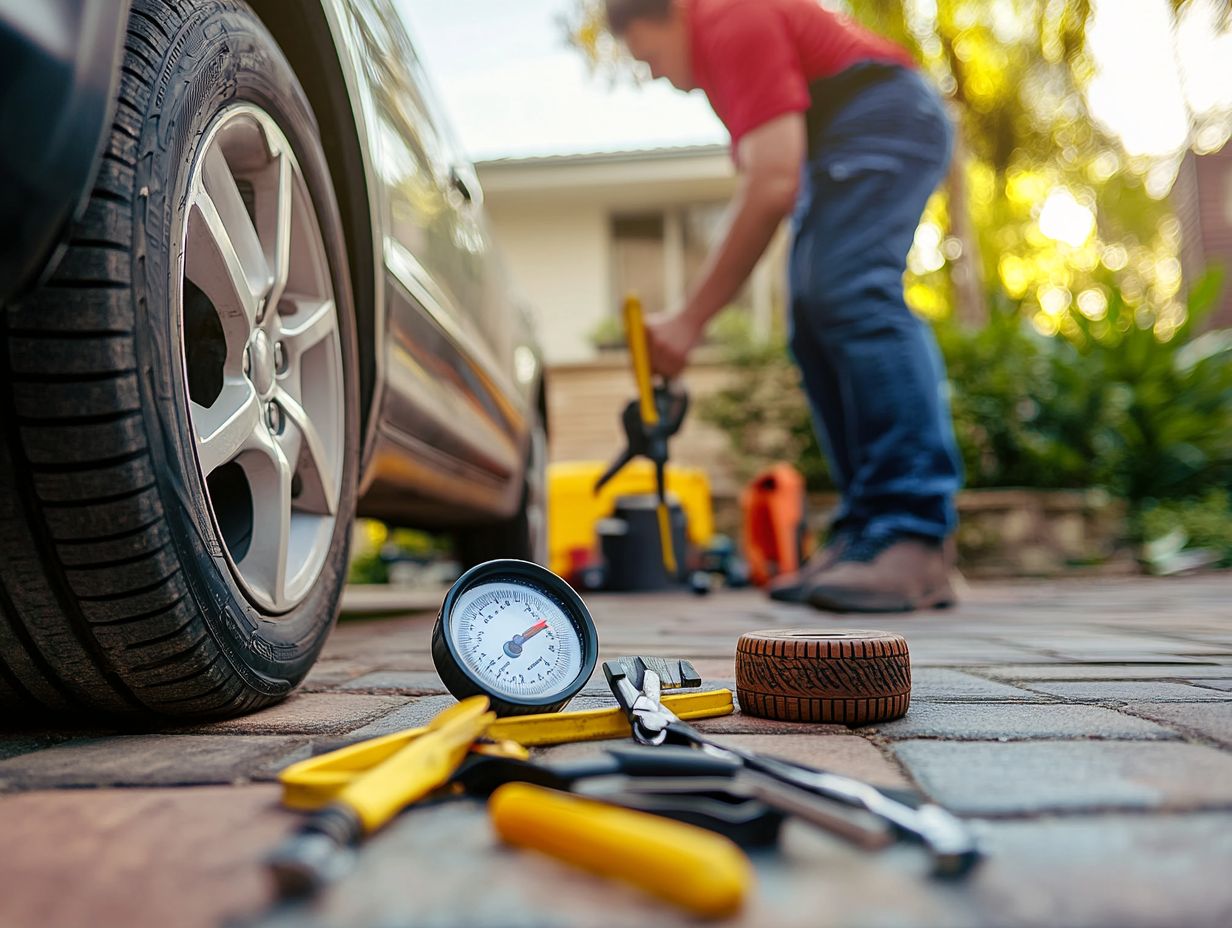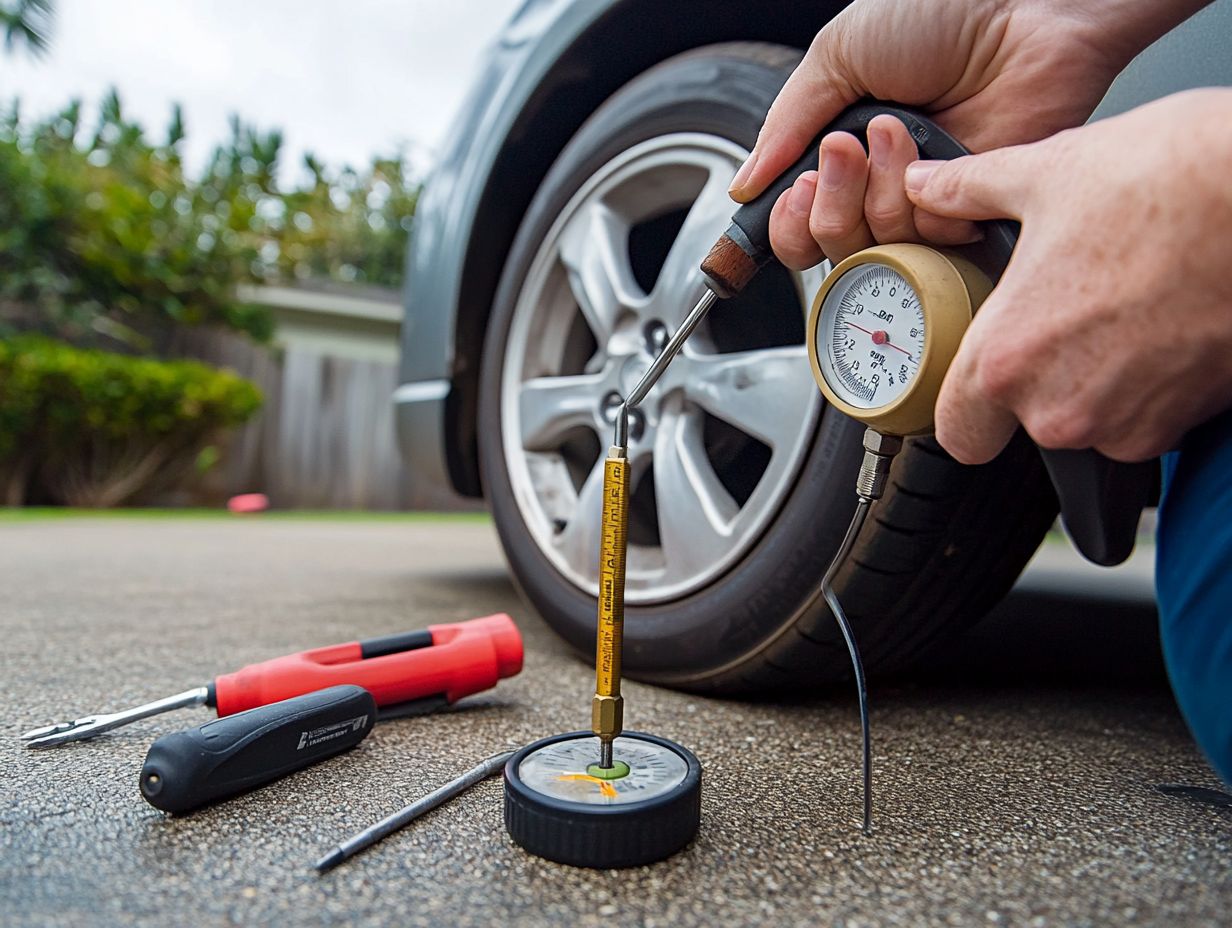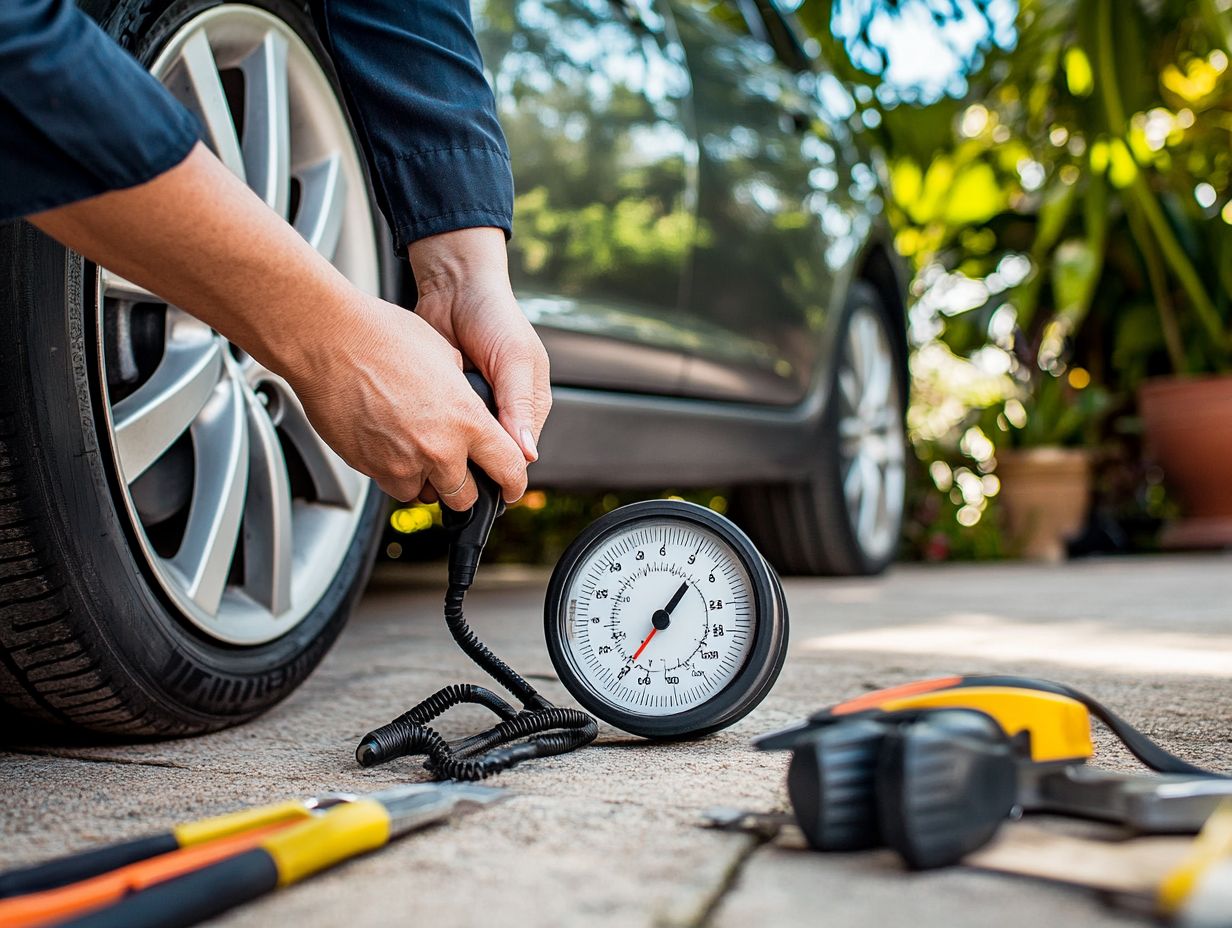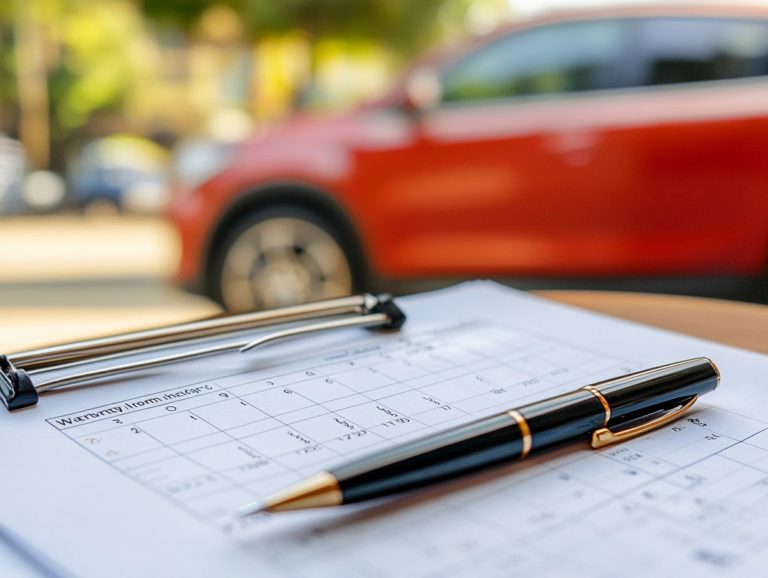How to Check Your Tire Pressure Correctly
Maintaining the right tire pressure is essential for your vehicle s performance, safety, and fuel efficiency. Get ready to dive in and ensure your tires are always road-ready!
Whether you re an experienced driver or just starting your journey as a car owner, understanding tire pressure can profoundly enhance your daily driving experience.
This guide delves into the importance of proper tire pressure, outlines the tools you ll need, and provides a clear, step-by-step method for checking it accurately.
You ll also discover common mistakes to avoid and invaluable tips for maintaining optimal tire pressure, ensuring a smoother, safer ride.
Contents
Key Takeaways:

- Proper tire pressure is crucial for optimal performance, fuel efficiency, and safety.
- Basic tools like a tire pressure gauge and tire inflator are necessary for accurate tire pressure checks.
- Check your tire pressure regularly to extend the life of your tires and improve your driving experience.
The Importance of Proper Tire Pressure
Maintaining proper tire pressure is essential for your vehicle’s performance and your safety. Regularly checking your tire pressure can help you avoid issues like underinflation, which increases rolling resistance and decreases fuel efficiency, and overinflation, which may lead to tire failure.
Automotive experts like Mike Parra emphasize that neglecting tire maintenance can significantly impact your vehicle s overall performance, resulting in unnecessary costs and risks. Ensuring your tires are properly inflated is a quick task that leads to better safety and efficiency.
Why Tire Pressure Matters
Tire pressure directly affects your vehicle’s safety, fuel efficiency, and the longevity of your tires. It’s essential to adhere to the recommended PSI (Pounds per Square Inch) specified in your owner s manual.
When you maintain proper tire pressure, it significantly influences tread wear, ensuring that your tires grip the road effectively and distribute weight evenly. Conversely, overinflation or underinflation can lead to uneven wear patterns, shortening the lifespan of your tires and increasing replacement costs.
Many new cars have a tire pressure monitoring system (TPMS) that alerts you when pressure is low, serving as a vital reminder for regular vehicle maintenance. Ignoring these warnings compromises your safety and can reduce fuel efficiency; under-inflated tires require more energy to move, negatively impacting your overall driving performance.
Tools Needed for Checking Tire Pressure
To effectively check and maintain your tire pressure, it’s essential to use the right tools. A reliable tire pressure gauge, especially a digital one, paired with an air compressor, makes this task straightforward and efficient.
Essential Equipment
Essential equipment for checking tire pressure includes a tire pressure gauge and an air compressor, both vital for accurate tire inflation and maintenance.
Choosing the right type of tire pressure gauge can enhance your vehicle’s performance and safety on the road. Digital, dial, and pencil gauges each have unique advantages, so understanding their functionalities is crucial. A reliable valve stem ensures accurate readings; any leak or damage can lead to misleading results.
When using the gauge, make sure it fits snugly on the valve stem to prevent air from escaping, as that can skew your measurements. Regular checks will improve your fuel efficiency and extend the life of your tires.
Step-by-Step Guide to Checking Tire Pressure

Checking your tire pressure is a simple yet crucial task that demands careful attention to detail. The ideal moment to perform this check is when your tires are cold, ensuring you receive an accurate PSI reading for optimal performance.
Instructions for Accurate Measurement
To achieve precise measurements when checking tire pressure, invest in a high-quality digital gauge and establish a monthly routine to maintain optimal performance.
Start by removing the valve cap from the tire. Securely press the gauge onto the valve stem, ensuring a tight seal to prevent any air from escaping. Once in place, the display will reveal the tire’s pressure in pounds per square inch (PSI), which should ideally align with the manufacturer’s recommended range typically found on the driver s side door or in the owner’s manual.
If the reading falls below the recommended level, add air gradually and recheck until you reach the desired pressure. If it’s too high, you may need to release some air.
Regularly checking your tires enhances fuel efficiency and extends their lifespan, contributing to a safer driving experience.
Common Mistakes to Avoid
Avoiding common mistakes when checking tire pressure is crucial for maintaining tire health and preventing issues such as tire failure. Be mindful of both underinflation and overinflation to ensure proper tire maintenance.
Errors that Can Affect Your Results
Overlooking common errors, such as the recommended PSI or not adjusting for temperature, can dramatically impact your tire pressure results. This can potentially lead to underinflation or overinflation.
These miscalculations jeopardize your safety, reduce fuel efficiency, and accelerate tire wear, resulting in expensive replacements. Many drivers mistakenly believe that a quick visual inspection is enough. However, tire pressure can fluctuate daily due to factors like changing weather conditions and driving habits.
This is where the tire pressure monitoring system (TPMS) becomes invaluable. It continuously evaluates tire inflation levels and alerts you to any deviations from the ideal range. By keeping a close eye on these readings, the TPMS helps ensure your vehicle operates smoothly, significantly enhancing both performance and safety on the road.
When to Check Tire Pressure
Understanding the importance of checking tire pressure is essential for ensuring your vehicle performs at its best. Check your tires on a monthly basis, ideally when they are cold, to obtain the most precise readings.
This simple yet vital practice can significantly enhance your driving experience and promote safety on the road.
Frequency and Timing

Conducting monthly tire pressure checks particularly when your tires are cold is vital for maximizing both the longevity and performance of your vehicle.
Regularly monitoring tire pressure is increasingly important, as temperature fluctuations throughout the year can significantly impact inflation levels. You might notice your tires lose about one PSI for every 10-degree drop in temperature, which could jeopardize your safety and fuel efficiency. Check the tire pressure before setting off on long journeys or after any significant temperature changes.
Maintaining proper tire inflation improves handling and traction while enhancing fuel economy. This is an essential aspect of vehicle maintenance that deserves your attention.
Maintaining Proper Tire Pressure
Maintaining proper tire pressure is crucial for your safety and performance, as well as for maximizing fuel efficiency and minimizing rolling resistance. Regular tire maintenance isn’t just a good idea; it’s a necessity that can significantly enhance your driving experience.
Don’t risk your safety check your tire pressure today!
Tips for Keeping Your Tires Inflated
To ensure your tires are properly inflated, it is essential to regularly check the valve stem for leaks. Use an air compressor to maintain the correct tire pressure.
Alongside these routine checks, looking closely at your tires can reveal any signs of wear or damage that may affect their performance. Staying informed about the manufacturer s recommended pressure levels is also beneficial; you can typically find this information inside the driver s door or in your owner s manual.
Engaging in regular tire rotations which means moving tires from one position to another ensures even wear across all tires. This extends their lifespan and enhances your vehicle’s handling.
By embracing these practical strategies, you play a key role in keeping your vehicle safe and efficient!
Frequently Asked Questions
How do I correctly check my tire pressure?
The correct way to check your tire pressure is to ensure that your tires are cold. This means not driving your car for at least 3 hours or driving less than 1 mile. Then, refer to this guide on how to check your tire pressure properly and use a tire pressure gauge to check the pressure of each tire individually.
Why should I check my tire pressure regularly?
Checking your tire pressure regularly is important because properly inflated tires ensure better fuel efficiency, longer tire life, and safer driving. It can also help prevent a blowout or flat tire while on the road.
How do I find the correct tire pressure for my vehicle?
The correct tire pressure for your vehicle can usually be found on a sticker located on the driver’s side door jamb or in your vehicle’s manual. You can also check with your tire manufacturer for the recommended pressure.
What s my next step if my tire pressure is low?
If your tire pressure is too low, you can use an air compressor to inflate the tire to the recommended pressure. Be sure to check the pressure again after adding air to ensure it is at the correct level.
Can I check my tire pressure while my car is on?
No, it is not recommended to check your tire pressure while your car is on. The heat from driving can cause the tires to expand, giving an inaccurate reading. Always check your tire pressure when the tires are cold.
How often should I check my tire pressure?
It is recommended to check your tire pressure at least once a month and before any long trips. If you notice any changes in your vehicle’s handling or your tire’s appearance, it is important to check the pressure immediately.






